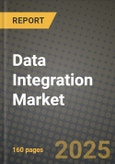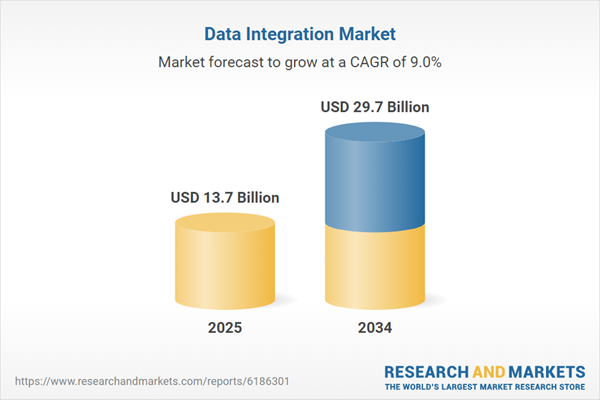The data integration market has become a fundamental component of modern data strategies, enabling organizations to seamlessly connect disparate systems, unify data from multiple sources, and ensure consistent and accurate information for decision-making and analysis. With businesses increasingly operating in hybrid and multi-cloud environments, data integration solutions have evolved to support complex workflows, high data volumes, and a growing variety of data formats. By simplifying the process of combining data across silos, integration tools empower organizations to gain deeper insights, improve operational efficiency, and enhance the overall value of their data assets.
The market witnessed significant advancements in automation, real-time integration, and support for new data paradigms. Vendors introduced more sophisticated integration platforms that leveraged artificial intelligence (AI) and machine learning (ML) to automate data mapping, detect anomalies, and recommend optimal data workflows. The rise of data fabric architectures provided organizations with a unified layer for data connectivity, allowing seamless access and integration across on-premises, cloud, and edge environments. Additionally, integration tools began incorporating enhanced data lineage, governance, and security features to help companies meet regulatory requirements and maintain trust in their data.
Looking forward, the data integration market is expected to grow steadily as businesses continue to adopt advanced analytics, artificial intelligence, and Internet of Things (IoT) technologies. The demand for real-time data streaming and event-driven integration will drive further innovation, while emerging trends such as data mesh architectures and decentralized data ownership will reshape how integration solutions are designed and deployed. As organizations place greater emphasis on data quality, consistency, and governance, the data integration market will remain a critical enabler of digital transformation and data-driven success.
Key Insights: Data Integration Market
- Increased adoption of AI and machine learning to automate data workflows and enhance accuracy.
- Emergence of data fabric and data mesh architectures for more flexible and scalable integration.
- Greater focus on real-time and event-driven integration to support dynamic business needs.
- Integration tools with built-in governance, security, and lineage tracking capabilities.
- Growing support for hybrid and multi-cloud environments, ensuring seamless data connectivity.
- Rising demand for data-driven decision-making across industries.
- Expanding volumes of data generated by IoT, social media, and cloud applications.
- Increased regulatory and compliance pressures necessitating transparent data flows.
- Advancements in analytics and machine learning requiring high-quality, integrated data.
- Managing the complexity of integrating diverse data sources and formats.
- High initial implementation costs and ongoing maintenance requirements.
- Ensuring consistent data quality and governance across decentralized environments.
Data Integration Market Segmentation
By Component
- Tools
- Services
- Professional Services
- Managed Services
By Deployment Mode
- Cloud
- On-Premises
By Organization
- Large Enterprises
- Small Enterprises
- Medium Enterprises
By Industry Vertical
- BFSI
- Retail and Consumer Goods
- Media and Entertainment
- Manufacturing
- Energy and Utilities
- Healthcare and Life Sciences
- Telecom and IT
- Government and Defense
- Transportation and Logistics
- Travel and Hospitality
- Academia and Research
Key Companies Analysed
- International Business Machines Corporation
- Microsoft Corporation
- SAP SE
- Oracle Corporation
- SAS Institute Inc.
- ServiceNow Inc.
- Hewlett Packard Enterprise Company (HPE)
- BMC Software Inc.
- Broadcom Inc. (formerly CA Technologies)
- Cherwell Software LLC
- Ivanti Inc.
- Axios Systems plc
- Citrix Systems Inc.
- Hornbill Systems Limited
- EasyVista Inc.
- Micro Focus International plc
- Atlassian Corporation Plc
- Alemba Limited
- SysAid Technologies Ltd.
- Freshworks Inc.
- SolarWinds Corporation
- Zendesk Inc.
- Agiloft Inc.
- TOPdesk International B. V.
- HappyFox Inc.
- Zoho Corporation Pvt. Ltd.
- Google Cloud Dataflow
- Amazon Web Services (AWS) Glue
- Informatica PowerCenter
- Talend Open Studio
Data Integration Market Analytics
The report employs rigorous tools, including Porter’s Five Forces, value chain mapping, and scenario-based modeling, to assess supply-demand dynamics. Cross-sector influences from parent, derived, and substitute markets are evaluated to identify risks and opportunities. Trade and pricing analytics provide an up-to-date view of international flows, including leading exporters, importers, and regional price trends.Macroeconomic indicators, policy frameworks such as carbon pricing and energy security strategies, and evolving consumer behavior are considered in forecasting scenarios. Recent deal flows, partnerships, and technology innovations are incorporated to assess their impact on future market performance.
Data Integration Market Competitive Intelligence
The competitive landscape is mapped through proprietary frameworks, profiling leading companies with details on business models, product portfolios, financial performance, and strategic initiatives. Key developments such as mergers & acquisitions, technology collaborations, investment inflows, and regional expansions are analyzed for their competitive impact. The report also identifies emerging players and innovative startups contributing to market disruption.Regional insights highlight the most promising investment destinations, regulatory landscapes, and evolving partnerships across energy and industrial corridors.
Countries Covered
- North America - Data Integration market data and outlook to 2034
- United States
- Canada
- Mexico
- Europe - Data Integration market data and outlook to 2034
- Germany
- United Kingdom
- France
- Italy
- Spain
- BeNeLux
- Russia
- Sweden
- Asia-Pacific - Data Integration market data and outlook to 2034
- China
- Japan
- India
- South Korea
- Australia
- Indonesia
- Malaysia
- Vietnam
- Middle East and Africa - Data Integration market data and outlook to 2034
- Saudi Arabia
- South Africa
- Iran
- UAE
- Egypt
- South and Central America - Data Integration market data and outlook to 2034
- Brazil
- Argentina
- Chile
- Peru
Research Methodology
This study combines primary inputs from industry experts across the Data Integration value chain with secondary data from associations, government publications, trade databases, and company disclosures. Proprietary modeling techniques, including data triangulation, statistical correlation, and scenario planning, are applied to deliver reliable market sizing and forecasting.Key Questions Addressed
- What is the current and forecast market size of the Data Integration industry at global, regional, and country levels?
- Which types, applications, and technologies present the highest growth potential?
- How are supply chains adapting to geopolitical and economic shocks?
- What role do policy frameworks, trade flows, and sustainability targets play in shaping demand?
- Who are the leading players, and how are their strategies evolving in the face of global uncertainty?
- Which regional “hotspots” and customer segments will outpace the market, and what go-to-market and partnership models best support entry and expansion?
- Where are the most investable opportunities - across technology roadmaps, sustainability-linked innovation, and M&A - and what is the best segment to invest over the next 3-5 years?
Your Key Takeaways from the Data Integration Market Report
- Global Data Integration market size and growth projections (CAGR), 2024-2034
- Impact of Russia-Ukraine, Israel-Palestine, and Hamas conflicts on Data Integration trade, costs, and supply chains
- Data Integration market size, share, and outlook across 5 regions and 27 countries, 2023-2034
- Data Integration market size, CAGR, and market share of key products, applications, and end-user verticals, 2023-2034
- Short- and long-term Data Integration market trends, drivers, restraints, and opportunities
- Porter’s Five Forces analysis, technological developments, and Data Integration supply chain analysis
- Data Integration trade analysis, Data Integration market price analysis, and Data Integration supply/demand dynamics
- Profiles of 5 leading companies - overview, key strategies, financials, and products
- Latest Data Integration market news and developments
Additional Support
With the purchase of this report, you will receive:- An updated PDF report and an MS Excel data workbook containing all market tables and figures for easy analysis.
- 7-day post-sale analyst support for clarifications and in-scope supplementary data, ensuring the deliverable aligns precisely with your requirements.
- Complimentary report update to incorporate the latest available data and the impact of recent market developments.
This product will be delivered within 1-3 business days.
Table of Contents
Companies Mentioned
- International Business Machines Corporation
- Microsoft Corporation
- SAP SE
- Oracle Corporation
- SAS Institute Inc.
- ServiceNow Inc.
- Hewlett Packard Enterprise Company (HPE)
- BMC Software Inc.
- Broadcom Inc. (formerly CA Technologies)
- Cherwell Software LLC
- Ivanti Inc.
- Axios Systems PLC
- Citrix Systems Inc.
- Hornbill Systems Limited
- EasyVista Inc.
- Micro Focus International PLC
- Atlassian Corporation PLC
- Alemba Limited
- SysAid Technologies Ltd.
- Freshworks Inc.
- SolarWinds Corporation
- Zendesk Inc.
- Agiloft Inc.
- TOPdesk International B. V.
- HappyFox Inc.
- Zoho Corporation Pvt. Ltd.
- Google Cloud Dataflow
- Amazon Web Services (AWS) Glue
- Informatica PowerCenter
- Talend Open Studio
Table Information
| Report Attribute | Details |
|---|---|
| No. of Pages | 160 |
| Published | October 2025 |
| Forecast Period | 2025 - 2034 |
| Estimated Market Value ( USD | $ 13.7 Billion |
| Forecasted Market Value ( USD | $ 29.7 Billion |
| Compound Annual Growth Rate | 8.9% |
| Regions Covered | Global |
| No. of Companies Mentioned | 30 |









